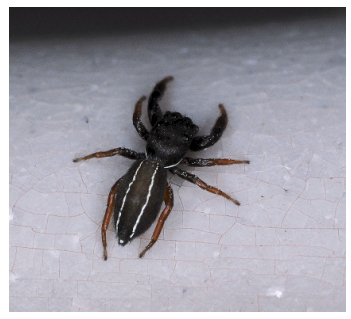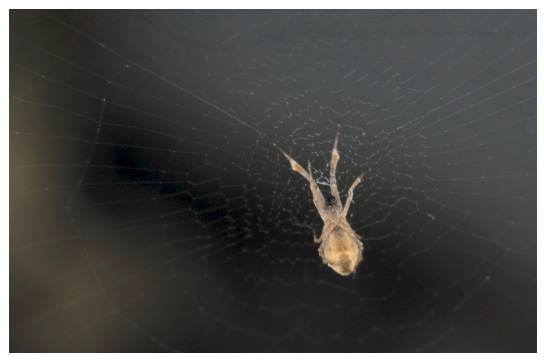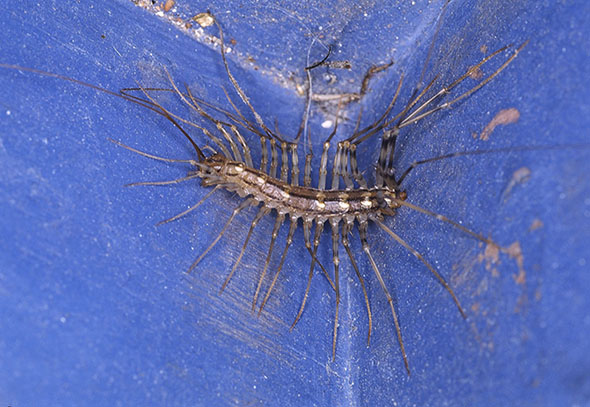
A jumping spider, Metacyrba taeniola, on the rim of a plastic pot in the insect garden.
|
AN INSECT GARDEN IN NEW MEXICO - 3
by David B.
Richman, |
The non-insect arthropod fauna of the insect garden, while probably not as varied as the insect fauna, is still quite diverse.Our understanding of the non-insect arthropods in any given area is fairly meager, often less than for at least some beetle families, such as the tiger beetles and scarabs for example. My insect garden in New Mexico is no exception, but I have been able to slowly document at least some of its members. Non-insect arthropods in the garden and surrounding area include centipedes, sowbugs, mites, and spiders.
My main interest is in spiders and so I will concentrate on these fascinating creatures. Probably my all time favorites are the jumping spiders (family Salticidae). These fascinating creatures have excellent vision for an invertebrate, and they can discriminate between shapes and between colors. Because of their excellent eyesight jumping spiders usually take notice of any movements, including those made by human observers. They exhibit some strategy in prey capture and use both sound and vision in courtship. The garden and associated trees have several species of these spiders in residence. Phidippus audax and Phidippus comatus are the largest of these, with P. audax reaching over 10 mm in length. On one occasion I watched a male P. audax trying to court a female on the sunflower leaves and I often see these spiders hunting flies and other small insects in the garden. On the ground it is possible to find Habronattus klauseri and Metacyrba taeniola. A currently undescribed species of Thiodina is common in the surrounding trees. Phidippus audax can occasionally bite, usually producing a short-lived, but very painful, reaction. The black and white body and brilliant metallic green chelicerae (mouthparts) make this one of the most attractive of spiders, but Metacyrba taeniola (as can be seen from the photograph) is also very attractive.

A jumping spider, Metacyrba taeniola, on
the rim of a plastic pot in the insect garden.
Other spiders found in or near the garden include a number of interesting species. Orb-weaving spiders (those that spin the classical wheel-shaped web) of the family Araneidae include the yellow garden spider (Argiope aurantia) (a rare visitor to the garden) and the more abundant Neoscona oaxcensis. Primitive haplogyne spiders are represented by the spitting spider (Scytodes sp: Family Scytodidae) and the European sowbug-eating spider (Dysdera crocata: family Dysderidae). Crab spiders (family Thomisidae) include the beautiful Misumenoides formocipes and Misumenops sp. Occasional wolf spiders (Pardosa sp. and Hogna sp.: family Lycosidae) show up at odd times.

A crab spider (Misumenoides formocipes)
on Tithonia.
Of course there is one bad actor. The western black widow (Latrodectus hesperus) is remarkably common in New Mexico. The bite of this comb-footed spider (family Theridiidae) can cause some alarming symptoms such as light fever, muscle aches and agitation. Our daughter was bitten by a young female- a few instars from adulthood- in her own bed. She experienced all of these symptoms but pain killers helped and after two days she recovered completely. The one good thing that can be said about black widow bite is that once recovered there are usually no after effects. The spider is found in most storage sheds, wood piles and other protected sites. However black widows have a few enemies in the spider world. In my shed, just north of the insect garden, the usual habitat for black widows has been taken over by a squint-eyed spider (Physocyclus enaulus: of the haplogyne family Pholcidae), a species that is araneophagic (eats other spiders) and preys on young black widows among others. Few black widows are found where Physocyclus sets up house keeping. Some years ago another araneophage pholcid, Holocnemis pluchei, was introduced to the United States from Europe and is now within a few blocks of the insect garden. I expect it to show up at any time. It also is a killer of young black widows, and (unfortunately) many other spiders as well.
The other bad actor in our area (which we have never seen in the garden or in our house) is the Apache violin spider (Loxosceles apachea: family Sicariidae). This spider is closely related to the infamous brown recluse (Loxosceles reclusa) and has similar venom. In this case there are often nasty sequelae if venom was actually injected. That said, violin spider envenomation is probably one of the most over-reported medical conditions in the country. When an actual bite does occur there can be tissue destruction around the bite site and occasionally more serious systemic problems, but not every such open sore is caused by spider bite.
One spider that shows up on plant pots near the garden is the strange orb-weaving feather-footed spider (Uloborus glomosus: Uloboridae). Unlike the araneid orb-weavers, which use capture silk with tiny globules of sticky material, uloborids use woolly silk to capture their prey. The silk works by entangling the claws of insects with tiny fibers produced by the cribellum, a flattened sieve plate anterior to the regular spinnerets on the ventral abdomen.

A feather-footed spider (Uloborus
glomosus) on its wooly silk web.
Probably one of the most abundant spiders in the garden is the striped lynx spider (Oxyopes salticus: family Oxyopidae). A sweep net swung through the grasses and composites will capture as many as a dozen of these spiny-legged hunters at a time. These neat spiders are important members of the natural enemies complex in agricultural fields where the kill and eat numerous pest species.
Occasionally small ground spiders (family Gnaphosidae) may be seen running on the ground in the garden. Other occasional visitors may include members of the families Corinnidae, Anyphaenidae, Miturgidae, Clubionidae and Tetragnathidae, among others. I have never seen any of the more primitive mygalomorphs, such as tarantulas or trapdoor spiders and I doubt I ever will. The insect garden area has had too turbulent a history for these conservative ancient ones.
The other small non-insect arthropods are not as varied as the spiders. Porcellio (the sowbug) and Armadillidium (the pillbug) are abundant and occasionally an infestation of spider mites might affect nearby conifers. I expect, but have not yet found, a centipede or two outside, but the only ones I have ever seen are European house centipedes (Scutigera coleoptera) inside the house. Also, even though New Mexico has over 20 species of scorpions, I have never seen one in the garden or house.

A
European house centipede (Scutigera coleoptera).
In closing I will add that despite the lack of time to enjoy the garden as much as I would like to, I have noticed a remarkable number of fascinating creatures. As I noted in my first essay, amateur biologists will find fertile fields for investigation in back yard gardens. In addition, on a more philosophical plane, a garden should be a place where we engage the real world around us. With the national and international news blaring hopelessness and despair I think it is often necessary to escape the increasingly unreal and even surreal human world to the delightful reality of the natural world. This world is to me at least neutral in general, if occasionally brutal in the specific, especially compared to the humanly constructed one that seems increasingly hostile. It has helped me gain enjoyment and perspective and I hope that you will find a similar enjoyment in the small creatures of this planet in your gardens!
Comments to the author, David Richman, are welcomed.
References (including those of use for amateurs in other parts of the world):
Dippenaar-Schoeman, A. S., and R. Jocque. 1997. African spiders: An identification manual. South Africa Plant Protection Res. Inst. (Johannesburg) Hbk. 9, 392 p. (Great introduction to the fantastic spider fauna of Africa).
Foelix, Rainer F. 1996. Biology of Spiders, 2nd ed. Oxford University Press, New York, 336 p. (The standard for the biology of spiders).
Gertsch, Willis J. 1979. American Spiders. 2nd ed. Van Nostrand Reinhold Co., New York, 274 p. (Good general account of American spider families.)
Jackman, John. A. 1999.A Field Guide to the Spiders and Scorpions of Texas. Gulf Pub. Co., Houston, TX, 202 p. (More up to date on spider classification, but localized for Texas).
Jones, Dick. 1983. The Larousse Guide to Spiders. Larousse Co., New York, 320 p. (A popular photographic guide to the spiders of Britain and northern Europe.)
Kaston, B. J. 1978. How to Know the Spiders. 3rd ed. MGraw-Hill, Boston, 272 p. (Quite a bit out of date, but still worth having.)
Levi, Herbert W. and Lorna R. Levi. 1968. Spiders and Their Kin. Golden Press, New York, 160 p. (Recently republished in a revised version, but still not totally up to date.)
Main, Barbara York. 1976. Spiders. Collins, Sydney 296 p. (Main did for Australian spiders, what Gertsch did for American spiders!)
Preston-Mafham, Rod and Ken Preston-Mafham. 1984. Spiders of the World. Facts on File, New York, 191 p. (An absolute gem of a book with beautiful color photographs of many unusual spiders.)
For those who might be interested the American Arachnological Society will be publishing a manual to North American spiders next year! This should bring the taxonomy and keys to genera up to date, while supplying a glossary of terms and an extensive bibliography. It will also have hundreds of illustrations, including dorsal-view drawings of representative species for each family. Any amateur or professional arachnologist in North America should find it an invaluable resource. You can preorder it on line from the American Arachnological Society if you wish. (END OF COMMERCIAL and no I don't get royalties!)
All photographs by David B. Richman.
Please report any Web problems or offer general comments to the Micscape Editor.
Micscape is the on-line monthly magazine of the Microscopy UK web site at Microscopy-UK.